| Article ID | Journal | Published Year | Pages | File Type |
|---|---|---|---|---|
| 2422678 | Aquaculture | 2012 | 5 Pages |
Chitin metabolism is of high relevance for shrimp growth because it has to be synthesized and cleaved in each molt. We studied chitin synthase and chitinase mRNAs from whiteleg shrimp Litopenaeus vannamei. For this, cDNA coding for cuticular chitin synthase (LvChS) and chitinase isoenzymes (LvChi1, LvChi2 and LvChi3) was amplified, sequenced and identified. In a qualitative analysis, LvChi1 and LvChi3 were detected only in the hepatopancreas and are probably involved in digestion of food chitin. LvChi2 transcript was found in pleopods, uropods, gills, eyestalk, and digestive tube; LvChi2 is likely to be involved in the hydrolysis of chitin from the exoskeleton and peritrophic membrane, but not in food chitin digestion. LvChS was found widely distributed in the organism, including the hepatopancreas. Thus, it seems to be involved in synthesis of chitin to build the exoskeleton and also the peritrophic membrane. Relative expression of LvChS and LvChi2 genes was evaluated by quantitative RT-PCR in the integument. These transcripts had a varying pattern of abundance during the molt cycle, based on the need of shrimp to synthesize or hydrolyze chitin from exoskeleton.
►In L. vannamei, ChS mRNA expresses in several organs. ►3 different Chi isoenzyme mRNAs have different putative roles. ►In the uropods, ChS mRNA is more abundant in postmolt stages. ►Chi2 mRNA is abundant in stages A and D0 with high variability among shrimps.
